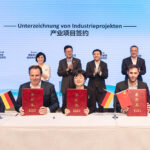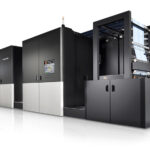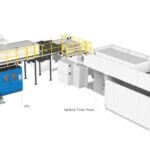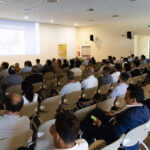CHINA: FACTS AND FIGURES Over 1,000 exhibitors over an area of 160 thousand sqm, of which 60% assigned in the last 7 months of last year. China Print 2013 thus becomes the second world printing and converting fair and prepares to debut at the New China International Exhibition Center in Peking, May 14th to 18th next. First-hand data and trends on the growth of China's industry in the sector and an exclusive interview with the director of the event, who speaks to Italian manufacturers.
by Elena Piccinelli
«Today is November 27th of the Chinese lunar calendar, and is also the coldest day of the year (-30 °C, Ed.). I see, however, that friends in the media in more than 20 countries worldwide and many representatives of the Chinese trade associations are participating at this event, in spite of the long journey and the harsh climate, and this warms my heart».
This the greeting that Yu Zhen (honorary chairman of China Machinery Industry Federation and the Printing and Printing Equipment Industries Association of China – Peiac) directed towards those convened at the presentation of China Print 2013: over 200 Chinese and Far Eastern correspondents of technical publications and representatives of industry associations, and from four magazines of the big European economies in the sector, namely Italy (represented by the publishing house of this magazine, Ed.) Germany, Russia and the UK.
Clicca per ingrandire l'immagine
 All came together in Peking on 8th and 9th January last of our calendar, to gather data and information on the evolution of printing and converting in what is now the second largest market in the world, as well as prime driver of world growth. But also to take stock of the Chinese fair, that has experienced spiralling growth: if last May – according to data communicated at drupa – the 100 thousand square meters of new exhibition space had already been sold out and the waiting list had grown to 200 companies; three months after, the construction of an additional pavilion could meet the excess demand and further requests to participate. At year’s end, therefore, the figures for China Print 2013 announced during the Peking press conference speak of 160 thousand square meters covered (+60% compared to last spring, with all the space again sold out), 1,000 exhibitors and 180 thousand visitors are expected, while other companies are poised to take any last minute availability.
All came together in Peking on 8th and 9th January last of our calendar, to gather data and information on the evolution of printing and converting in what is now the second largest market in the world, as well as prime driver of world growth. But also to take stock of the Chinese fair, that has experienced spiralling growth: if last May – according to data communicated at drupa – the 100 thousand square meters of new exhibition space had already been sold out and the waiting list had grown to 200 companies; three months after, the construction of an additional pavilion could meet the excess demand and further requests to participate. At year’s end, therefore, the figures for China Print 2013 announced during the Peking press conference speak of 160 thousand square meters covered (+60% compared to last spring, with all the space again sold out), 1,000 exhibitors and 180 thousand visitors are expected, while other companies are poised to take any last minute availability.
Meanwhile, the organizers inform us that the sister fair in southern China is also growing. The third edition of Print China will be held in 2015 at Dongguan, China’s prime print district, with a longer duration compared to the previous event in 2011 (6 days instead of 5) and legitimate expectations of further growth, based on an economy that, after the recent slowdown, is now speeding forward again.
 Locomotive of the world
Locomotive of the world
That China, while paying high costs from many sides, has been capable of proceeding with a titanic modernisation plan is before everyone’s eyes. Evident too the fact that the country is now not only principal growth driver for the Far East but also for the world as a whole. The figures of this growth were given by Yu Zhen, honorary president of the Chinese Federation of machine manufacturers and of Peiac, during the press conference.
Recovery accelerating – Over the last thirty years, since the start of the reform policies and opening up of the market, the Chinese economy has always put in double-digit growth figures. At the end of 2011 it reached a GDP of 47.3 trillion renminbi (RMB), or about 7.4 trillion U.S. dollars, and became to all effects the second-largest world economy. The global economic crisis has also affected the Asian giant, but as the speaker stresses, the measures taken by the Chinese government brought speedy relief, allowing the country to close 2012 with a growthrate of around +7.5%: no longer to two digits that is, but well above the performance of the western countries… In addition, growth projects set for the next period include, among other things, the doubling of GDP compared to 2010 (at a level of 100 trillion RMB) and the formation of a middle class of 5-6 billion people, "essential prerequisite for the sustainable growth of the economy”. And the first results are already beckoning.
The print industry is changing and growing (**) – In the same period the print industry experienced exponential growth. In 1978 the turnover of the sector was only 4.8 billion RMB, while at the end of 2011 it stood at 867.7 billion (multiplied 180 fold!) placing the country second in the sector world ranking, directly behind the United States.
China numbers some 102 thousand print concerns, that employ over 3.5 million people. Of this universe, 47 thousand concerns (46% of the total) are focused on packaging and make a turnover of RMB 631.8 billion (72% of the total) showing an annual growthrate of 20.6%. Some 6800 print concerns (6.85% of total) make books and periodicals, with a turnover of 131.3 billion RNB, showing an annual growthrate of 0.94%. A full 48 thousand (47% of the total) instead operate in other areas and, in spite of decreasing trends (-15%), attained a turnover of 104.4 billion (12% of the total).
In 2011, moreover, the export of printed products touched values of 68 billion RMB, with an annual growthrate of 2.8%, accounting that is for less than 8% of the total value of sector turnover. The Chinese printing industry, the speaker concluded, is therefore still in a state of flux and is dominated by domestic demand.
Machines – Focusing on printing and converting machines, the Chinese industry is "worth" about 50 billion RMB (equivalent to 8.3 billion USD), with imports of 2.54 billion USD in 2011 (+10.6%) and exports of 1.25 US dollars (+1.1%). Local constructors number around 800 and produce mostly medium and low-end products to meet the domestic demand and, in part now also demand from abroad.
The machinery sector is going through a phase of changes and concentrations: Shanghai Electrics recently bought up Akiyama and Goss International, Han-Gronhi has bought up Shinohara and the Founder Group; Tianjin Masterwork has also made major purchases in the fields of digital and post press and, in general, Chinese machine manufacturers are poised to tackle the high end of the market. Over 280 Chinese concerns attended drupa, occupying an area of 11 thousand square meters, double the previous edition, to the point that China ranked second in the number of exhibitors and third in size of their stands: the hall hosting the Peiac collective totalled 168 concerns covering over 9,000 sqm of floorspace.
The value of culture – The spiralling growth of the print sector is fuelled by domestic demand and, going by official statistics, will continue to do so for several years to come. Government plans require massive investment in the cultural and creative industries, offering new growth opportunities to tools and technology suppliers.
In figures, the publishing industry is "worth" 1.5 trillion RMB, 867.7 billion of which to be attributed to the print industry; by the end of the twelfth Development Plan (2016) the Chinese publishing industry is set to double its turnover, prospecting an equally glowing future for the sector. Even so, the speaker considers, "apart from air and water, any type of material can be printed on" and technology is running at full speed (at the beginning of year, at Xian the first store for 3D printing was opened, Ed.).
(**) Further information on structures and trends in the in the print and graphics segment in China a Basic introduction of Chinese Printing Market in 2011
The opportunity for an encounter
The international conference held last January by the organizers of China Print featured two intense days of talks, meetings, visits to companies and institutions.
It was, therefore, a valuable opportunity to take a look close to at a country of prime importance in the political and economic equilibrium of the planet, at its companies as well as the business approach and the type of organization adopted by of China Print and Peiac operators.
But it was also, no mean thing, an opportunity to meet the people – the organizers of the fair, colleagues invited to the conference, entrepreneurs … – to compare cultures and sensitivities and, last but not least, enjoy the warm Chinese hospitality.
During the two-days of Beijing this was expressed in the abundance of delicious food and repeated toasts, in the patient helpfulness of China Print employees and gaiety of the gala dinner which, after the greetings and thanks to all those who have contributed to the success of the fair, carried on informally amidst traditional and non traditional performances (from the women’s band to folk rock to juggling, going by way of ancient theatre and the draw of the many prices offered by Apple).
Here is the calendar of proceedings and list of speakers who provided information and data on the Chinese print market and its qualitative and quantitative trends, on the imminent edition of China Print and the offer at the fair.
• January 8th featured a report on the Chinese economy, the state of the industry and the fair China Print given by: Yu Zhen, honorary president of China Machinery Industry Federation (CMIF) and PEIAC, Yu Ping, vice chairman of the China Council for the Promotion of International Trade (CCPIT), Wu Feng, spokesman for the Ministry of Industry and Information Technology Model PRC (MIIT); Yin Haixing, vice president of the China International Exhibition Center Group Corporation (CIEC), Zhang Jianmin, general secretary of the digital printing of PEIAC Li Chen, director of the Committee Services PEIAC and secretary general of China Print Awards competition; Xie Senshu, Deputy Secretary General of PEIAC and general manager of China Print Show Company Ltd.
Information was then anticipated on products to be presented at the fair along with their particular approach to the markets of the Far East by the representatives of: Heidelberg, Indigo, Komori, Konica Minolta, Founder Group, Kodak Graphic Communication, Shanghai Electric Printing and Packaging Machinery Group (SPPM), Beiren Printing Machinery Holdings Ltd., manroland, Hangzhou CRON Machinery & Electronics Company Ltd.
• On January 9 a delegation of journalists visited the Tianjin Masterwork, first Chinese manufacturer of laminators and cutters, which opened the gates of their modern factory and a private print museum of particular interest and beauty. The encounter, hosted by the president of the board of directors and GM Li Li together with the company top management, was followed by a visit to one of the vast industrial areas emerging from scratch in the Beijing region and lastly to the new exhibition center where China Print 2013 will be held.













